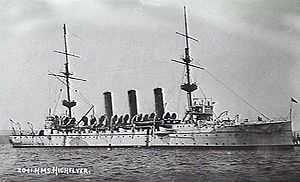Highflyer-class cruiser
 | |
| Class overview | |
|---|---|
| Name: | Highflyer |
| Operators: |
|
| Preceded by: | Pelorus class |
| Succeeded by: | Challenger class |
| Completed: | 3 |
| Lost: | 1 |
| Scrapped: | 2 |
| General characteristics | |
| Type: | Protected cruiser |
| Displacement: | 5,600 long tons (5,690 t) |
| Length: | 350 ft (106.7 m) (p/p, 372 ft (113.4 m) (o/a) |
| Beam: | 54 ft (16.5 m) |
| Draught: | 22 ft (6.7 m) |
| Installed power: | 10,000 ihp (7,460 kW) 18 water-tube boilers |
| Propulsion: | 2 shafts 2 × Vertical triple-expansion steam engines |
| Speed: | 20 knots (37 km/h; 23 mph) |
| Complement: | 450 |
| Armament: |
|
| Armour: | Deck: 1.5–3 in (38–76 mm) Gun shields: 3 in (76 mm) Conning tower: 6 in (152 mm) |
The Highflyer-class cruisers were a three-ship class of second-class protected cruisers of the Royal Navy, laid down in 1897 and completed at an average cost of £300,000.
They were essentially repeats of the Eclipse class, but carried eleven 6-inch main guns as the main armament instead of the mix of 6 inch and 4.7 inch guns used on the earlier ships. They also used water tube boilers like the Arrogant class, with slightly upgraded machinery, but unlike the Arrogant class they were not designed to act as rams. The water tube boilers raised the speed of the ships by half a knot, and were 100 tons lighter than the boilers used in the Eclipse-class ships, almost making up for the increased weight of the guns. With the very similar Challenger-class ships they were the last British light cruisers before HMS Bristol was laid down in 1909.
Ships
- HMS Highflyer - launched on 4 June 1898, she served on numerous stations and hunted commerce raiders. She was sold for scrapping 10 June 1921, by then the last Victorian era cruiser in service with the Royal Navy.
- HMS Hermes - launched on 7 April 1898, she was converted to a seaplane carrier in 1913, and sunk on 31 October 1914 by U 27
- HMS Hyacinth - launched on 27 October 1898, she served on southern stations in the First World War, and assisted in the blockade of SMS Königsberg. She was sold for scrapping on 11 October 1923.
See also
References
- Colledge, J. J.; Warlow, Ben (2006) [1969]. Ships of the Royal Navy: The Complete Record of all Fighting Ships of the Royal Navy (Rev. ed.). London: Chatham Publishing. ISBN 978-1-86176-281-8. OCLC 67375475.
- Jane's Fighting Ships of World War One (1919), Jane's Publishing Company
- Highflyer class in World War I
- History of the Highflyer class
- Highflyers
- Experimental seaplane carrier Hermes
External links
| Wikimedia Commons has media related to Highflyer class cruiser. |
| ||||||||||
| ||||||||||||||||||||||||||||||||||||||||||||||||||||||||||||||||||